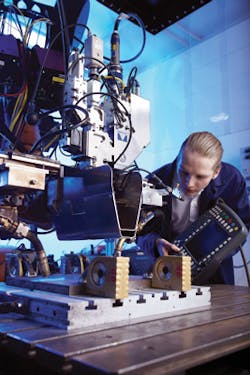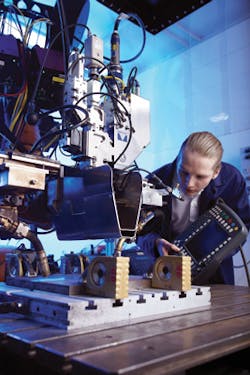HYBRILAS project develops process for quick laser welding of thick sheets
Gaggenau, Germany – Scientists at the Laser Center in Hanover, as part of the joint project HYBRILAS, have developed a laser welding process that can be used to make single-sided, zero-defect welds in aluminum sheets up to a thickness of 12mm. To achieve this, they combined a laser beam with two gas metal arc welding (GMAW) torches.
The ScanTracker of Precitec's YW52 welding head has an integrated scanner mirror that allows the laser beam to make a pendulum movement across or along the feed direction, enabling the effective width of the laser beam to be flexibly set. The welding seam width is exactly as wide as necessary and permits the highest possible welding speed.
The joining process achieves high feed speeds of 5–6m/min, and is able to bridge gap widths of up to 0.4mm and edge misalignment of up to 2mm. With steel materials, sheets up to 23mm thick can be welded in a single layer at a speed of 1.5m/min.
This innovative process is extremely fast compared to conventional methods with multiple-layer GMAW processes, the seam geometry is very narrow, and filler material consumption is considerably lower, creating a high-quality weld seam. The lower heat input and less severe component distortion means the combined process has other advantages over conventional methods. The hybrid welding process uses a solid-state disk laser with an output power of 16kW.
To join a steel sheet with a thickness of 30mm, conventional GMAW requires tack welds and approximately six filler layers. The hybrid process only needs two to three layers. The first layer is made using the laser-GMAW hybrid process. It replaces the tack welds and the first four layers of the conventional gas metal arc weld. Subsequently, the sheets are subject to one or two backing runs with the GMAW process. So, the hybrid welding process is able to weld a 1.5m-long component within 1min, whereas the conventional process takes requires 12min.
The joining project "HYBRILAS: welding thick sheets with brilliant laser beam sources" was part of an initiative called "MABRILAS: Material processing with brilliant laser beam sources," and was promoted by the Federal Ministry for Training and Research and coordinated by the VDI Technology Center.
Shiloh Industries develops lightest blanks in the industry
Valley City, OH – Lightweighting, noise, and vibration solutions supplier Shiloh Industries revealed the industry's lightest aluminum door blank for mass production without compromising part integrity or formability. This breakthrough allows automakers to further reduce mass compared to existing methods.
"This advancement is the result of combining our expertise in aluminum, our laser welding proficiency, and our commitment to lightweighting by providing innovative solutions to our customers," said Ramzi Hermiz, Shiloh president and CEO. "Our new proprietary laser welding process overcomes the current challenges with weld integrity and offers the perfect solution for OEMs utilizing or considering aluminum in their vehicle portfolio."
This innovation provides automakers a significant weight saving compared to traditional methods—even lightweighting existing aluminum components. As an example, four aluminum, single-piece (monolithic) door-inner blanks of similar geometry weigh 35.5 lb, whereas Shiloh's aluminum laser-welded door-inner blanks weigh 26.8 lb—a reduction of nearly nine pounds or 25 percent per vehicle. Furthermore, carmakers switching from steel monolithic blanks to aluminum laser-welded blanks save nearly 58 lb per vehicle. The Environmental Protection Agency states that even small weight savings directly equates to improved overall fuel economy.
Shiloh is able to deliver lightweighting solutions in steel, steel alloys, aluminum, and magnesium.
"Aluminum laser welding is the latest example of Shiloh's focus on delivering lightweighting solutions without compromising safety, strength, or noise and vibration," added Hermiz.

